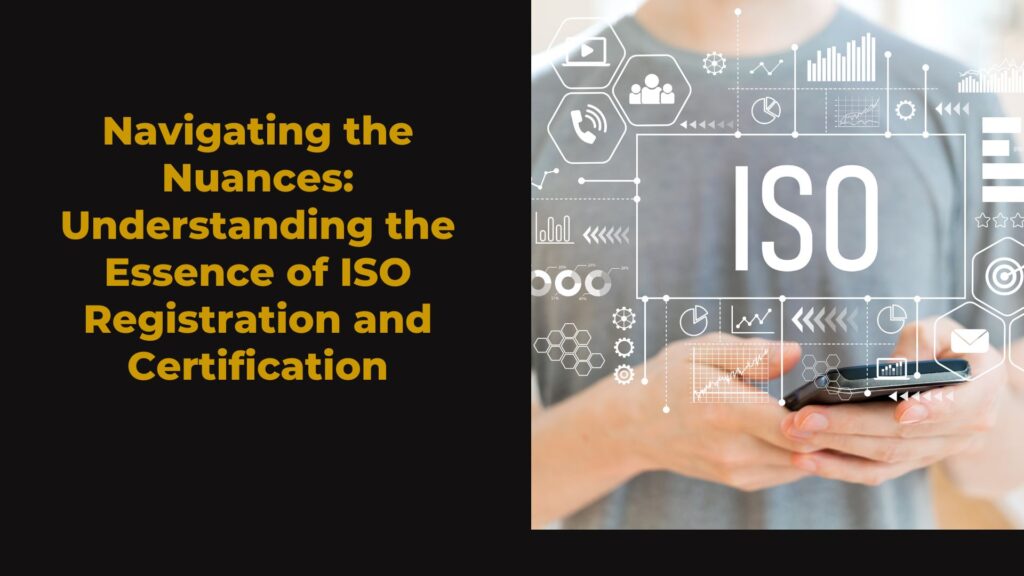
Navigating the Nuances: Understanding the Essence of ISO Registration and Certification
Introduction:
In the realm of quality management and organizational excellence. The International Organization for Standardization (ISO) stands as a beacon of credibility and assurance. Yet, within the vast landscape of ISO standards, there exists a common confusion surrounding the terms “registration” and “certification.” Are they interchangeable? Do they denote the same process? Unraveling these intricacies is crucial for businesses aiming to embrace ISO standards effectively. In this comprehensive exploration, we delve into the essence of ISO, dissecting the disparities between registration and certification. And illuminating their significance in contemporary business contexts.
Note: You Can Apply for ISO 29993-2017 Certification Through ISO Portal
Understanding ISO:
Before delving into the dichotomy between registration and certification. It’s imperative to grasp the fundamental purpose and structure of the International Organization for Standardization. Established in 1947, ISO is an independent, non-governmental international organization comprising members from various national standardization bodies. ISO develops and publishes international standards that define best practices in numerous industries, ranging from quality management to environmental sustainability. These standards serve as benchmarks for organizations striving to enhance efficiency, quality, and safety across their operations.
Deciphering Registration vs. Certification:
At the heart of ISO’s ethos lie two pivotal processes: registration and certification. While often used interchangeably, these terms encapsulate distinct procedures, each playing a crucial role in the pursuit of organizational excellence.
Registration:
ISO registration, also referred to as “registration to ISO standards” or “ISO registration,” primarily involves a formal declaration by an organization that it conforms to a specific ISO standard. Contrary to popular belief, ISO itself does not conduct registrations. Instead, organizations enlist the services of independent auditors or certification bodies to assess their compliance with ISO standards. Upon successful evaluation, the organization receives a registration certificate, affirming its adherence to the prescribed requirements of the respective ISO standard. It’s important to note that ISO registration does not imply formal recognition by ISO; rather, it signifies conformity to the standard’s specifications as assessed by an external auditor.
Certification:
In contrast, ISO certification denotes a more comprehensive validation of an organization’s conformity to ISO standards. Certification involves a rigorous assessment conducted by accredited certification bodies, which are impartial entities authorized by national accreditation bodies. These assessments encompass thorough reviews of the organization’s processes, systems, and practices to ascertain compliance with the relevant ISO standard. Upon satisfactory evaluation, the certification body issues a certification, attesting that the organization meets the criteria outlined in the ISO standard. ISO certification is widely regarded as a testament to an organization’s commitment to quality, providing stakeholders with a tangible assurance of its capabilities and credibility.
Distinguishing Features:
While registration and certification share the common objective of affirming compliance with ISO standards, several key distinctions set them apart:
Scope of Assessment:
ISO registration typically involves a narrower scope of evaluation, focusing on specific processes or aspects of an organization’s operations. In contrast, ISO certification entails a more exhaustive scrutiny, encompassing the entirety of the organization’s quality management system.
Level of Assurance:
While ISO registration provides a basic level of assurance regarding conformity to ISO standards. ISO certification offers a higher degree of assurance. As it involves a more rigorous and comprehensive assessment process.
Recognition:
ISO registration does not entail formal recognition by ISO, as it is conducted by independent auditors or certification bodies. Conversely, ISO certification grants formal recognition by accredited certification bodies, enhancing the organization’s credibility and market competitiveness.
Market Perception:
ISO certification is often perceived more favorably by stakeholders, including customers, partners, and regulatory authorities, due to its stringent validation process and formal recognition. In contrast, ISO registration may not carry the same level of credibility in the eyes of stakeholders.
Implications for Organizations:
The choice between ISO registration and certification holds profound implications for organizations seeking to leverage ISO standards to enhance their operations and reputation. While ISO registration offers a cost-effective means of demonstrating compliance with specific standards. ISO certification provides a comprehensive validation of organizational excellence, bolstering credibility and market competitiveness. However, the decision should be informed by various factors, including industry requirements, stakeholder expectations, and organizational objectives.
Conclusion:
In essence, the disparity between ISO registration and certification lies in the depth of assessment, level of assurance, and market recognition. While both processes serve as valuable tools for organizations aspiring to uphold international standards of excellence, understanding their nuances is essential for making informed decisions and maximizing the benefits derived from ISO conformity. By navigating these intricacies adeptly, organizations can embark on a transformative journey towards sustainable growth, operational efficiency. And stakeholder trust in an increasingly competitive global landscape.






Leave Your Comment